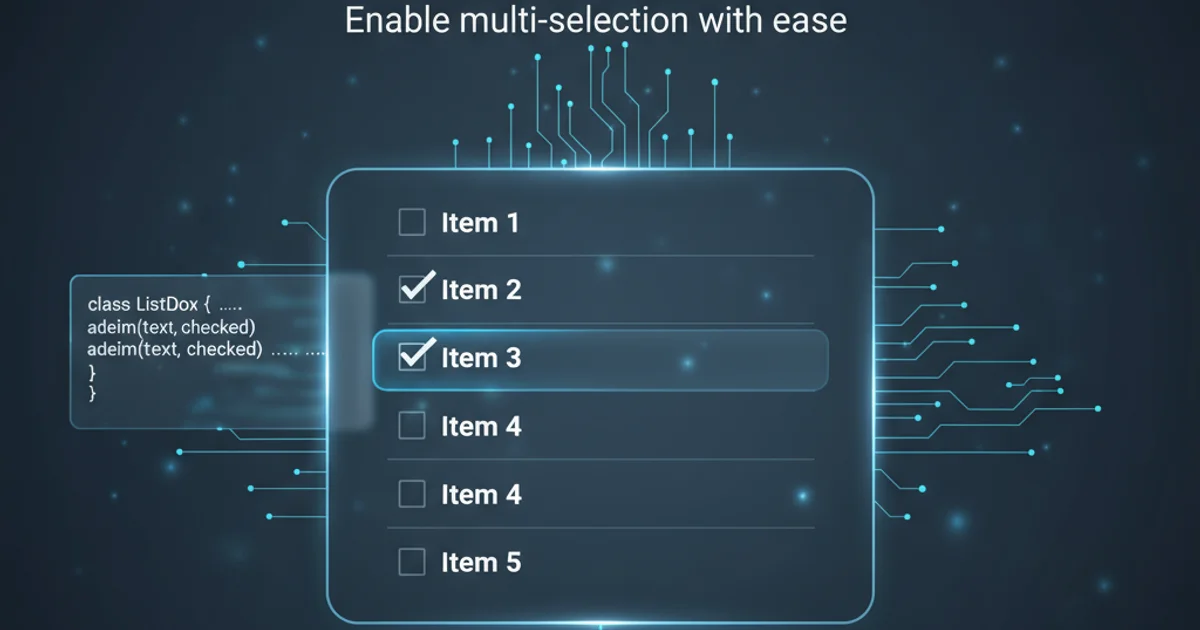Adding checkbox controls to list box
Categories:
Adding Checkbox Controls to a ListBox in C#

Learn how to enhance a standard Windows Forms ListBox control by integrating checkboxes, allowing users to select multiple items with visual cues. This guide covers custom drawing and event handling.
The standard ListBox control in Windows Forms is excellent for displaying a list of items, but it lacks built-in support for checkboxes next to each item. While you can use a CheckedListBox for simple scenarios, it doesn't offer the same level of customization as a custom-drawn ListBox. This article will guide you through the process of adding fully functional checkbox controls to a regular ListBox, providing a more flexible and visually integrated solution for multi-selection.
Understanding the Approach: Owner-Drawn ListBox
To add checkboxes to a ListBox, we need to make it an "owner-drawn" control. This means we take over the responsibility of painting each item in the list. By doing so, we can draw a checkbox alongside the item's text. We'll also need to manage the checked state of each item and handle user clicks to toggle these checkboxes.
This approach involves several key steps:
- Setting the
DrawModeproperty toOwnerDrawFixedorOwnerDrawVariable. - Handling the
DrawItemevent to custom paint each item. - Handling the
MouseDownevent to detect clicks on the checkbox area and update the item's checked state. - Storing the checked state for each item, typically within a custom object or a separate collection.
flowchart TD
A[Start: Initialize ListBox] --> B{Set DrawMode to OwnerDrawFixed}
B --> C[Handle DrawItem Event]
C --> C1[Draw Background]
C1 --> C2[Draw Checkbox]
C2 --> C3[Draw Item Text]
C --> D[Handle MouseDown Event]
D --> D1{Click within Checkbox Bounds?}
D1 -- Yes --> D2[Toggle Item's Checked State]
D1 -- No --> D3[Handle Standard ListBox Selection]
D2 --> E[Invalidate ListBox Item]
E --> F[End: Update UI]Flowchart of the custom-drawn ListBox process.
Implementing a Checkable ListBox Item Class
To effectively manage the checked state and display text for each item, it's best to create a custom class that encapsulates these properties. This class will represent a single item in our ListBox.
public class CheckableListBoxItem
{
public string Text { get; set; }
public bool IsChecked { get; set; }
public CheckableListBoxItem(string text, bool isChecked = false)
{
Text = text;
IsChecked = isChecked;
}
public override string ToString()
{
// This is important for the ListBox to display the text correctly
return Text;
}
}
Definition of the CheckableListBoxItem class.
Configuring the ListBox and Handling Drawing
Now, let's configure our ListBox control. We'll set its DrawMode and subscribe to the DrawItem and MouseDown events. The DrawItem event is where we'll perform the custom rendering of the checkbox and text.
using System.Drawing;
using System.Windows.Forms;
public partial class MyForm : Form
{
private ListBox myListBox;
public MyForm()
{
InitializeComponent();
InitializeMyListBox();
}
private void InitializeMyListBox()
{
myListBox = new ListBox();
myListBox.Location = new Point(10, 10);
myListBox.Size = new Size(200, 150);
myListBox.DrawMode = DrawMode.OwnerDrawFixed; // Fixed height for simplicity
myListBox.ItemHeight = 20; // Adjust as needed
myListBox.DrawItem += MyListBox_DrawItem;
myListBox.MouseDown += MyListBox_MouseDown;
this.Controls.Add(myListBox);
// Add some sample items
myListBox.Items.Add(new CheckableListBoxItem("Item 1"));
myListBox.Items.Add(new CheckableListBoxItem("Item 2", true));
myListBox.Items.Add(new CheckableListBoxItem("Item 3"));
myListBox.Items.Add(new CheckableListBoxItem("Item 4"));
}
private void MyListBox_DrawItem(object sender, DrawItemEventArgs e)
{
if (e.Index < 0 || e.Index >= myListBox.Items.Count)
return;
e.DrawBackground();
CheckableListBoxItem item = myListBox.Items[e.Index] as CheckableListBoxItem;
if (item == null)
{
// Fallback for non-CheckableListBoxItem items
e.Graphics.DrawString(myListBox.Items[e.Index].ToString(), e.Font, new SolidBrush(e.ForeColor), e.Bounds.Left + 2, e.Bounds.Top + 2);
e.DrawFocusRectangle();
return;
}
// Define checkbox bounds
Rectangle checkboxRect = new Rectangle(e.Bounds.Left + 2, e.Bounds.Top + 2, 16, 16);
// Draw the checkbox
ControlPaint.DrawCheckBox(e.Graphics, checkboxRect, item.IsChecked ? ButtonState.Checked : ButtonState.Normal);
// Define text bounds (offset from checkbox)
Rectangle textRect = new Rectangle(
checkboxRect.Right + 4, // 4 pixels padding after checkbox
e.Bounds.Top,
e.Bounds.Width - checkboxRect.Width - 6,
e.Bounds.Height
);
// Draw the item text
e.Graphics.DrawString(item.Text, e.Font, new SolidBrush(e.ForeColor), textRect, StringFormat.GenericDefault);
e.DrawFocusRectangle();
}
private void MyListBox_MouseDown(object sender, MouseEventArgs e)
{
int index = myListBox.IndexFromPoint(e.Location);
if (index >= 0 && index < myListBox.Items.Count)
{
CheckableListBoxItem item = myListBox.Items[index] as CheckableListBoxItem;
if (item != null)
{
// Check if the click was within the checkbox area
Rectangle checkboxRect = new Rectangle(myListBox.GetItemRectangle(index).Left + 2, myListBox.GetItemRectangle(index).Top + 2, 16, 16);
if (checkboxRect.Contains(e.Location))
{
item.IsChecked = !item.IsChecked;
myListBox.Invalidate(myListBox.GetItemRectangle(index)); // Redraw only the clicked item
}
}
}
}
}
C# code for initializing the ListBox, handling DrawItem, and MouseDown events.
DrawMode to OwnerDrawVariable and handling the MeasureItem event to specify the height of each item dynamically.Retrieving Selected Items
Once the user has interacted with the checkboxes, you'll likely want to retrieve the list of checked items. This can be done by iterating through the ListBox.Items collection and checking the IsChecked property of each CheckableListBoxItem.
using System.Collections.Generic;
using System.Linq;
// ... inside your form or a relevant method
private List<CheckableListBoxItem> GetCheckedItems()
{
List<CheckableListBoxItem> checkedItems = new List<CheckableListBoxItem>();
foreach (object item in myListBox.Items)
{
if (item is CheckableListBoxItem checkableItem && checkableItem.IsChecked)
{
checkedItems.Add(checkableItem);
}
}
return checkedItems;
}
// Example usage:
private void buttonShowCheckedItems_Click(object sender, EventArgs e)
{
List<CheckableListBoxItem> selected = GetCheckedItems();
string message = "Checked Items:\n" + string.Join("\n", selected.Select(i => i.Text));
MessageBox.Show(message);
}
Method to retrieve all checked items from the ListBox.
ListBox implementation provides a flexible alternative to CheckedListBox when you need more control over the appearance and behavior of individual items, or when integrating checkboxes into an existing ListBox that already uses custom objects.